|
|
|
Sort Order |
|
|
|
Items / Page
|
|
|
|
|
|
|
| Srl | Item |
| 1 |
ID:
128675
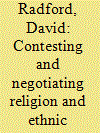

|
|
|
|
|
| Publication |
2014.
|
| Summary/Abstract |
Post-Soviet Central Asia has inherited a set of circumstances conducive to the revitalization of religion. The renewal of Muslim awareness and identity in Central Asia may not be surprising, but the growth of Christianity is, especially in its Protestant form within indigenous Muslim communities. This article, based on qualitative field research, reviews one example of this development: the process of conversion to Protestant Christianity among Muslim Kyrgyz in Kyrgyzstan. A prominent aspect of this social movement has been the ways in which Kyrgyz Christians have entered into a dynamic process of engaging with issues of identity and what it means to be Kyrgyz - a process that has sought to locate their new Christian religious identity within, rather than on the margins of, familial and ethnic identity, and one that challenges the normative understanding of Kyrgyz identity: that to be Kyrgyz is to be Muslim. While providing the context for Kyrgyz conversion, this discussion primarily focuses on the way Kyrgyz Christians utilize a number of different discursive strategies to contest normative Kyrgyz identity constructs and to legitimize a Kyrgyz Christian identity.
|
|
|
|
|
|
|
|
|
|
|
|
|
|
|
|
| 2 |
ID:
128715
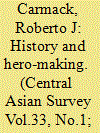

|
|
|
|
|
| Publication |
2014.
|
| Summary/Abstract |
This article analyses Soviet agitprop that was produced for Kazakhstani soldiers during the Great Patriotic War. The author argues that one of the main goals of this propaganda was to cultivate a complementary Soviet-Kazakh identity. Conditions at the front made this difficult to accomplish, but Soviet propagandists persisted in tailoring their propaganda for the benefit of Kazakh soldiers. As the war progressed, Kazakh front-line propaganda acquired a more unambiguously Soviet orientation, a consequence of the elimination of key themes derived from Kazakh national history and considered too politically volatile by the Communist Party. The article concludes by suggesting that the narratives articulated during World War II by Soviet propagandists went a long ways towards setting the contours of a prescribed Soviet-Kazakh identity.
|
|
|
|
|
|
|
|
|
|
|
|
|
|
|
|
| 3 |
ID:
128690


|
|
|
|
|
| Publication |
2014.
|
| Summary/Abstract |
Using materials gathered during fieldwork carried out in Russia in 2008 and 2009, this paper examines the 'Day of Stavropol' krai 2009' celebration and links it to debates on ethnic relations, identity and nationalism in post-Soviet Russia. It is argued that celebrations, festivals, parades and other 'spectacles' are significant, yet often overlooked, influences on ethnic relations. Although authorities at national and regional scale play a prominent role in governing ethnic relations, it is often the case that they revert to Soviet-era practices - such as the 'folklorization' of ethnic groups - and produce a narrative that proclaims the 'eternal harmony' of ethnic relations. Given widespread ethnic tensions that exist in Russia, such a representation of ethnic relations is far from the reality lived by people in everyday life. Thus, this paper explores how citizens' understandings of ethnic relations relates to that portrayed by state authorities.
|
|
|
|
|
|
|
|
|
|
|
|
|
|
|
|
| 4 |
ID:
128663


|
|
|
|
|
| Publication |
2014.
|
| Summary/Abstract |
This article examines how possibilities for Muslim expression were and are shaped by the political imaginaries in Soviet-era and independent Uzbekistan. It develops the concept of social 'imaginary' in Charles Taylor's critique of Western secular modernity. Political imaginaries are the assumptions about the nature of being, the essential categories through which the world is understood and acted upon, that are produced within dominant state discourses and that shape the space for the political. The article compares the Soviet vision of socialist modernity and the logic of the current state ideology in independent Uzbekistan, and discusses how these have framed the possibilities for being Muslim. It argues that the category of culture is produced in distinct and contrasting ways in these imaginaries, and plays a central role in delineating the public space for Islam.
|
|
|
|
|
|
|
|
|
|
|
|
|
|
|
|
| 5 |
ID:
128698
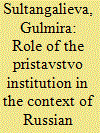

|
|
|
|
|
| Publication |
2014.
|
| Summary/Abstract |
The institution of pristavstvo was introduced in the Kazakh Steppe in the first decade of the nineteenth century. This institution had different meanings and functions, from an individually held position (e.g., a pristav to the kh?n of the Junior Horde in 1820; the pristavs who accompanied the Kazakh delegation to Saint Petersburg in the first half of the nineteenth century) to an administrative-territorial structure (e.g., the pristavstvo of the Senior Horde; the Mangyshlak and Zaisan pristavstvos). Though the political structure of the Russian empire had included institutions analogous to the pristavstvo, it was not a conventional component of the Russian administrative system. Studying the features of the pristavstvo institution in the territory of Kazakhstan and analysing the transformation of the pristav's function provide new insights on how the multi-ethnic Russian empire was managed. They will also help scholars to better understand the forms and methods the Russian authorities employed to manage their nomadic populations.
|
|
|
|
|
|
|
|
|
|
|
|
|
|
|
|
| 6 |
ID:
128704
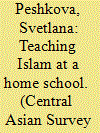

|
|
|
|
|
| Publication |
2014.
|
| Summary/Abstract |
In this article I describe and analyse non-institutionalized religious education among local women in Uzbekistan. I argue that while exhibiting vestiges of 'traditional' objectives, methods of teaching, and models of knowledge transmission, and incorporating elements of educational reforms advocated by the Central Asian reformers in the early 1900s, and of Soviet pedagogy, the dynamics of such education foster students' critical thinking. By enabling students to think critically about their lives and social environment, the non-institutionalized religious education does not have one predetermined outcome, but ensures social change that starts on an individual level, whereby a student can, but does not have to, engage politically with the state, which systematically intervenes in shaping its citizens' religious lives.
|
|
|
|
|
|
|
|
|
|
|
|
|
|
|
|
| 7 |
ID:
128684
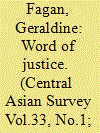

|
|
|
|
|
| Publication |
2014.
|
| Summary/Abstract |
How does state repression of non-militant Muslims contribute to violent Islamism in the North Caucasus? This article considers the case of the republic of Kabardino-Balkaria, where young residents' embrace of normative Islam post-perestroika roiled the Sovietized Muslim and secular establishments. Greatly aggravated by the brutal and indiscriminate response from law enforcement agencies, this confrontation culminated in the 2005 Nalchik uprising, the North Caucasus' largest insurgent offensive of the past decade. In the culturally comparable nearby republic of Adygeya, by contrast, analogous state repression in the wake of the uprising did not produce a violent outcome. Salient features of the mosque-state relationship in both republics are examined here, particularly the rationale of Kabardino-Balkaria's Muslim opposition leaders before and after their public endorsement of militant jihadism. The author then posits ways of marginalizing such leaders and thereby limiting the scope for conflict.
|
|
|
|
|
|
|
|
|
|
|
|
|
|
|
|
|
|
|
|
|